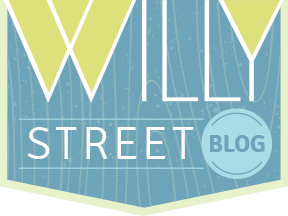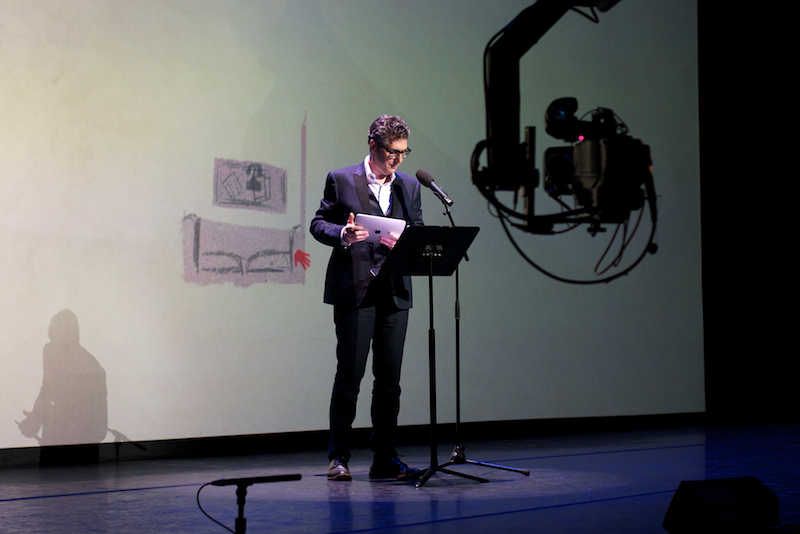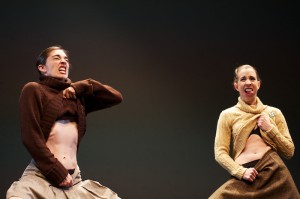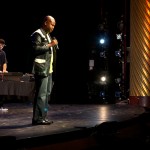This American Life pulls off another great live stage show
I waited to write about the recent “This American Life” stage show in New York (May 10), beamed live to theaters around the world, since Ira Glass intoned us to not give away all the surprises due to a rebroadcast scheduled for the following week. This show, “The Invisible Made Visible”, was a natural evolution of TAL’s first live simulcast in 2009 and featured elements you just can’t do on the radio like animation, dance numbers, and using a smartphone app to play along Rock Band-style with the hand bell wielding members of OK Go.
As usual TAL’s program staff, led by Ira Glass, stocked the show with a strong eclectic mix of veteran contributors like David Sedaris, David Rakoff, and Mike Birbiglia; along with new voices like radio host Glynn Washington, Comedian Tig Notaro, and Ryan Knighton.
Interspersed between the familiarly formatted storytelling were two dance performances by the ultra-modern dance group Monica Bill Barnes & Company which Glass saw last summer and basically admitted that the impetus for the live show began after seeing their performance.
What is a live show beamed to several hundred movie theaters around the world without an icebreaker? That was provided by OK Go, which used a set of hand bells normally seen in church to ring out a tune. However, this being the blended media age, the performance also involved the use of an app. I didn’t realize that there was an app associated with the show but many folks around me in the theater whipped out their phones and were ready to play along.
OK Go’s Andy Ross coded the app along with help from two others who made the visuals and video that played on the left side of a giant screen while OK Go played their bells on the right. A series of colored shapes descended on the screen and when they hit the “play bar” people with the app were to press a left, right, or center button on their device. Each app opened to a different color.
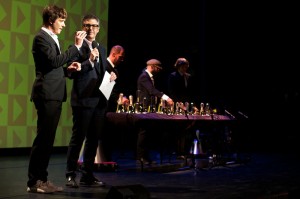
OK Go provided an interactive musical experience that required the audience to use a special app on their smartphones designed especially for the show. Photo by: Adrianne Mathiowetz
The rest of us were relegated to luddite status, but OK Go thought of us and we became the percussion section, stomping our feet or snapping our fingers when our “white” shapes appeared at the proper moments. In setting up the piece, Glass gave us humorous details of the lengths he had to go to get theater managers to allow cell phone use during the show. It was no small task as the shame of a ringing cell phone in a theater is firmly ingrained in society.
Its one of the reasons Ira Glass is one of the greatest set-up men in media. His highly scripted introductions sound so off-the-cuff, yet vulnerable as though he was just someone in the audience who was thrust on-stage to emcee the evening. I think that is why Glass is the sinews that bind this show together. He exudes the emotions we all feel about the material and how we talk about it; its like being in a perpetual dinner party conversation.
The TAL style of radio presentation has influences of its own in shows like “Planet Money” and other shows and podcasts where radio magazines are no longer presented as announcer followed by a report, but a conversation that weaves in the material that we all are used to hearing.
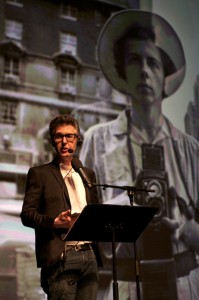
TAL tackles a story that wouldn’t work on radio, the monster cache of negatives by recluse street photographer Vivian Maier. Photo by: Adrianne Mathiowetz
Glass loves to make the mystery of radio, visual. Before the 2009 film, he often toured, doing a stage version of his radio show, usually just him, sitting behind a desk and playing audio clips, but adding in cogent and entertaining comments. Some of those elements were present during “The Invisible Made Visible” as he stopped the show a few times to voice a few scripted cues that are familiar to listeners of the weekly radio show. It may have been a live event, but Glass was sure to show the audience how radio sausage was made.
Irony was alive and well as Glass started the show with some of that sausage making by showing how he produces the opening segment, playing cuts from an interview with blind-since-childhood Ryan Knighton. As he spoke live he played the clips from an iPad (including a funny quip about his recent run-in with Apple) and behind him was animation to illustrate the story. That story was followed by an on-stage appearance by Knighton who told his own story about his young daughter discovering his blindness and how the lack of sight can cloud the meaning of bear and BEAR!
David Sedaris didn’t disappoint, relating an experience about the seething hate that can develop while waiting in line for coffee behind latte-ordering noobs. David Rakoff, known for dark and pensive stories, delivered in a plaintive style, went for poignant as he celebrated a medical procedure that relieved him of long-term pain but also the function of one of his limbs. However, the triumph of the story was a dance he performed that was touching beyond words.
Vivian Maier was an incredible street photographer in the Chicago area that no one really knew about until Jon Maloof discovered thousands of negatives in an attic. The story would not have been possible on the weekly show, but was presented in the spirit of TAL with stunning images, along with video interviews.
Public radio’s Snap Judgment host Glynn Washington related a childhood experience of being an African-American family moving to the rural southern plains and tackling such challenges such as where to drill a well. Tig Notaro almost stole the show with her story about repeated encounters with singer Taylor Dayne, which brought lots of laughs, but it’s worth listening to hear who gets the last one.
I’m relating all the great performances out of order, but I am saving one of the best for last. Mike Birbiglia was an up and coming talent when he told this incredible story during the 2009 show. He has become a rockstar in the TAL pantheon since then, with a new feature film “Sleepwalk With Me”, due out in August (produced and co-written with Ira Glass). As a preview to the film, Mike teamed up with the Queen of the Public Radio interview “Fresh Air” host Terry Gross to present a hilarious short that cannot be described, it must be watched:
Think you have a story or the skillz to get your piece on “This American Life”? Here is my submission from 2009, which was rejected.
You can find out more about submitting your story to TAL here and here.
